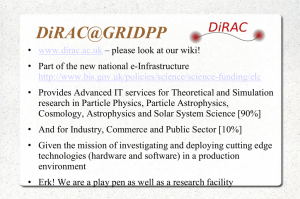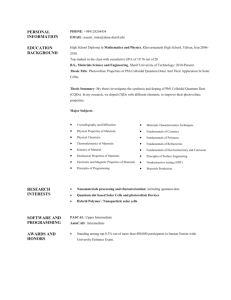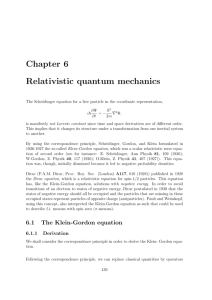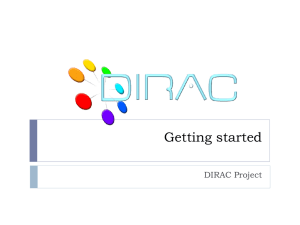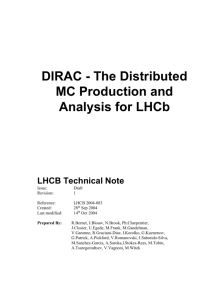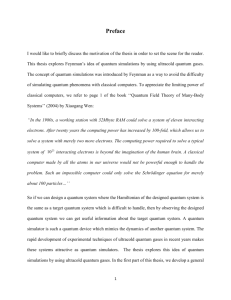LanZ_0112_eps(1)
advertisement
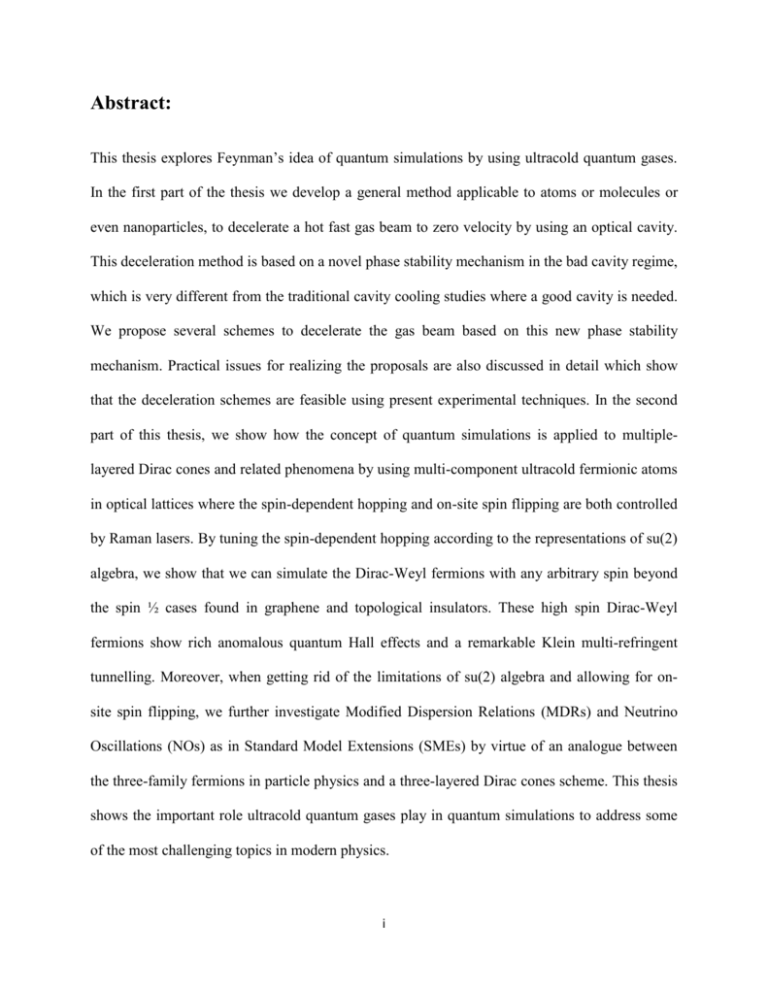
Abstract: This thesis explores Feynman’s idea of quantum simulations by using ultracold quantum gases. In the first part of the thesis we develop a general method applicable to atoms or molecules or even nanoparticles, to decelerate a hot fast gas beam to zero velocity by using an optical cavity. This deceleration method is based on a novel phase stability mechanism in the bad cavity regime, which is very different from the traditional cavity cooling studies where a good cavity is needed. We propose several schemes to decelerate the gas beam based on this new phase stability mechanism. Practical issues for realizing the proposals are also discussed in detail which show that the deceleration schemes are feasible using present experimental techniques. In the second part of this thesis, we show how the concept of quantum simulations is applied to multiplelayered Dirac cones and related phenomena by using multi-component ultracold fermionic atoms in optical lattices where the spin-dependent hopping and on-site spin flipping are both controlled by Raman lasers. By tuning the spin-dependent hopping according to the representations of su(2) algebra, we show that we can simulate the Dirac-Weyl fermions with any arbitrary spin beyond the spin ½ cases found in graphene and topological insulators. These high spin Dirac-Weyl fermions show rich anomalous quantum Hall effects and a remarkable Klein multi-refringent tunnelling. Moreover, when getting rid of the limitations of su(2) algebra and allowing for onsite spin flipping, we further investigate Modified Dispersion Relations (MDRs) and Neutrino Oscillations (NOs) as in Standard Model Extensions (SMEs) by virtue of an analogue between the three-family fermions in particle physics and a three-layered Dirac cones scheme. This thesis shows the important role ultracold quantum gases play in quantum simulations to address some of the most challenging topics in modern physics. i Acknowledgements: It is my pleasure to thank Dr. Weiping Lu for sharing his knowledge of cold molecules to me. The first part of this thesis has benefited greatly from his helpful comments and constructive criticisms. Thanks are also given to Dr. Yongkai Zhao and Dr. Peter Barker for their help on the first part of my PhD work. I gratefully acknowledge the support from Dr. Patrik Öhberg who supervised the second part of this thesis and initiated the collaborations with Dr. Nathan Goldman, and Dr. Alejandro Bermudez, and also arranged for me to visit Prof. Maciej Lewenstein, and Dr. Alessio Celi at ICFO. It has been a privilege to work with such distinguished scientists. I also would like to thank my wife, Jia Lin and our daughter Enyu Lan for their love. Last but not least, I would like to thank SUPA for providing me with a prize studentship and travel grants for my PhD study. This thesis is based on the following papers: Cavity-based Molecular Decelerators 1. Zhihao Lan, Yongkai Zhao, Peter F. Barker and Weiping Lu, Deceleration of molecules in a supersonic beam by the optical field in a low-finesse cavity, Phys. Rev. A 81, 013419 (2010). 2. Zhihao Lan and Weiping Lu, Cavity-induced phase stability to decelerate a fast molecular beam via feedback-controlled time-varying optical pumps, New J. Phys. 13, 023031(2011). Quantum Simulations on Layered Dirac Cones 3. Z. Lan, N. Goldman, A. Bermudez, W. Lu and P. Öhberg, Dirac-Weyl fermions with arbitrary spin in two-dimensional optical superlattices, Phys. Rev. B 84, 165115 (2011). 4. Z. Lan, A. Celi, W. Lu, P. Öhberg and M. Lewenstein, Tunable multiple layered Dirac cones in optical lattices, Phys. Rev. Lett. 107, 253001 (2011). ii Contents: Abstract …………………………………………………………………………………………...i Acknowledgements………………………………………………………………………………ii Contents……………………………………………………………………………………...…..iii Preface…………………………………………………………………………………………….1 PART I: Decelerations due to Cavity-Induced Phase Stability……………………………….3 Chapter One: Introduction……………………………………………………………………...4 1.1 Background……………………………………………………………………………..……. 4 1.2 Model……………………………………………………………………………………….....9 Chapter Two: Cavity-induced phase stability ………………………………………………..12 2.1 Linear stability analysis and phase transitions……………………………………………….14 2.2 Formation of travelling molecular packets…………………………………………………..18 Chapter Three: Deceleration schemes………………………………………………………...24 3.1 Bad cavity regime …………………………………………………………………………...25 3.1.1The deceleration principle…………………………………………………………………..25 3.1.2 Numerical simulations……………………………………………………………………..27 3.2 Intermediate cavity regime…………………………………………………………………..32 iii 3.2.1 The deceleration principle………………………………………………………………….32 3.2.2 Numerical simulations……………………………………………………………………..34 3.3 Composite scheme…………………………………………………………………………...38 Chapter Four: Practical issues and outlook………………………………………………......41 4.1 Practical issues……………………………………………………………………………….41 4.2 Conclusions and outlook…………………………………………………………………….47 PART II: Quantum Simulations of Multiple-layered Dirac Cones in Optical Lattices…... 50 Chapter Five: Dirac cones and Dirac fermions……………………………………………….51 5.1 Background…………………………………………………………………………………..51 5.2 The Hamiltonian……………………………………………………………………..............54 5.3 Experimental setup…………………………………………………………………………...55 Chapter Six: Hopping dynamics and multiple-layered Dirac cones………………………...60 6.1 Hopping matrices according to the representations of the su(2) Lie Algebra……………….61 6.2 Anomalous Hall effects……………………………………………………………………...63 6.2.1 Continuum description: Weyl-Landau levels……………………………………………..64 6.2.2 Lattice description: computing the Chern number…………………………………………71 6.3 Multi-refringent Klein tunnelling …………………………………………………………...77 iv 6.4 Generalizations to tunable effective speeds of light ………………………………………...83 Chapter Seven: Onsite dynamics and mixing of Dirac species………………………………86 7.1 Exotic particle dispersions……………………………….. ………………..………………..86 7.2 Neutrino oscillations …………………………….………………………………………..…87 Chapter Eight: Experimental detections and outlook………………………………………..95 8.1 Experimental detections……………………………………………………………………...95 8.2 Conclusions and outlook……………………………………………………………………..97 Conclusions……………………………………………………………………………………...99 Appendix A…………………………………………………………………………………….102 Appendix B…………………………………………………………………………………….105 References……………………………………………………………………………………...107 v






